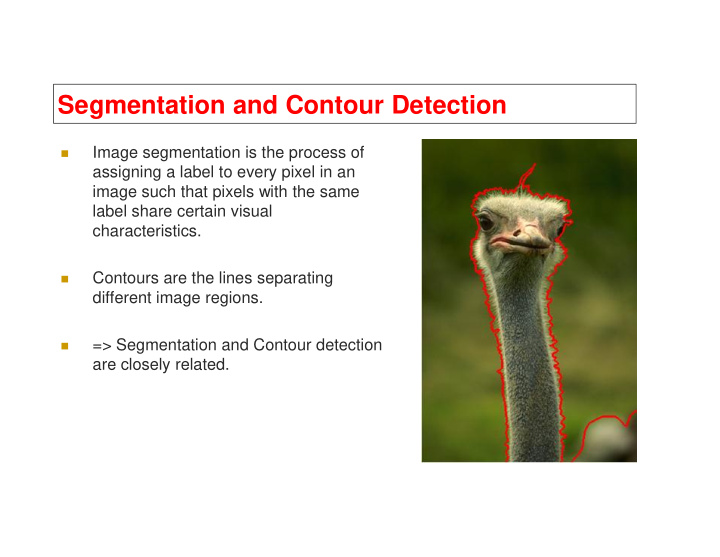



Segmentation and Contour Detection Image segmentation is the process of assigning a label to every pixel in an image such that pixels with the same label share certain visual characteristics. Contours are the lines separating Contours are the lines separating different image regions. => Segmentation and Contour detection are closely related.
What is segmentation? Dividing image into its constituent regions or objects
Problem Statement
Berkeley Segmentation Dataset Berkeley Segmentation dataset (BSDS500). 500 Manually segmented images. Manual Segmentations
Hard Edges vs. Soft Edges Hard Edges vs. Soft Edges
λ= λ= λ=3 0 8 2
Consistency A Perceptual organization forms a tree: Image BG BG L-bird L-bird R-bird R-bird B C grass bush far Two segmentations are beak body beak body consistent when they can be eye head eye head explained by the same • A,C are refinements of B segmentation tree (i.e. they • A,C are mutual refinements could be derived from a single • A,B,C represent the same percept perceptual organization). • Attention accounts for differences
Combining Segmentations Combining Segmentations
How To Combine How To Combine Segmentations Segmentations? ? Option A: Spectral Clustering Choose N nearest neighbors for each pixel. 1. Calculate sparse affinity matrix. 2. Use spectral clustering to get K segments. 3. Find contours. Find contours. 4. 4. 2 3 4 1 . . .
How To Combine How To Combine Segmentations Segmentations? ? Option B: Directly combine contours of segmentations Find contour of a single segmentation 1. Combine all contours. 2. 1 1 2 . . .
Segmentation Discontinuity Gray value detection Similarity Thresholding Thresholding Detection of: Detection of: Isolated points Region growing Lines Region splitting and merging Edges
Dealing with textures Similarity in Color Similarity in Texture 16
Why supervised? 17
Dimensionality Reduction Color & Texture Descriptor Reduced noise Curse of dimensionality Less computational load 18
Converting textures to “color” channels 19
Local Color Histogram Measures color mixtures in small windows (11x11) Clustering the histograms of the image into 10 groups. Assigning each pixel to the centroid of its cluster. 20
Gabor Filters – Cont. 21
Gabor filters Zsa Zsa Gabor Dennis Gabor 6 February 1917, Budapest, Hungary 5 June 1900, Budapest, Hungary
Gabor Filters
Gabor Filter Bank Example Scale σ σ σ 3 1 2 θ 1 Orientation θ 2 θ 3 θ 4 Example Gabor filter bank with 3 scale values and 4 orientation values:
Gabor filter responses
Standard way to handle texture Apply Gabor filter bank and generate a texture vector for each pixel. Perform Kmeans/GMM/pca on the texture vector space, each group centroid is called vector space, each group centroid is called texton For each pixel(texton) neighborhood, calculate texton histogram The resulting histogram values are the texton vector space.
Chi square distance between texton histograms Chi-square i 0.1 0.1 j j k 0.8 2 K [ h ( m ) h ( m )] 1 χ i j 2 ( h , h ) i j 2 h ( m ) h ( m ) m 1 i j
Scale-Space Basics

Recommend
More recommend